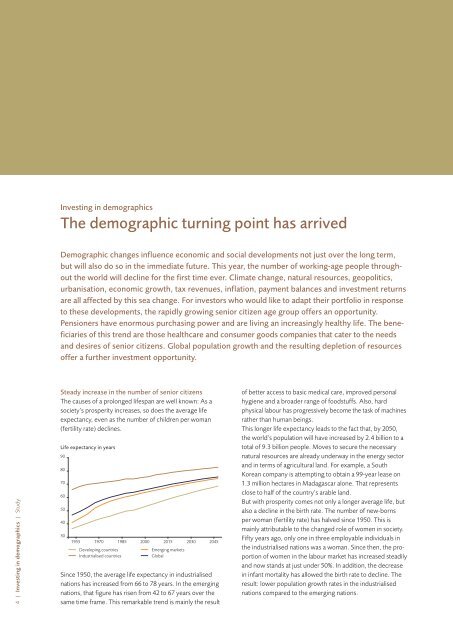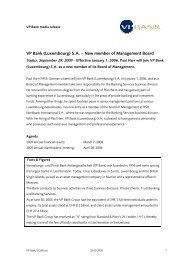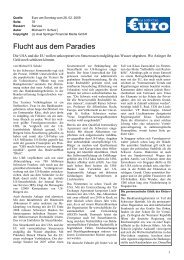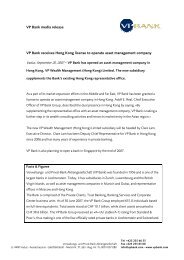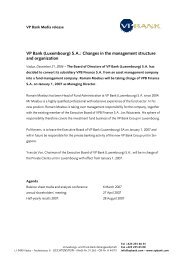Investing in demographics
Investing in demographics
Investing in demographics
Create successful ePaper yourself
Turn your PDF publications into a flip-book with our unique Google optimized e-Paper software.
4 | <strong>Invest<strong>in</strong>g</strong> <strong>in</strong> <strong>demographics</strong> | Study<br />
<strong>Invest<strong>in</strong>g</strong> <strong>in</strong> <strong>demographics</strong><br />
The demographic turn<strong>in</strong>g po<strong>in</strong>t has arrived<br />
Demographic changes <strong>in</strong>fluence economic and social developments not just over the long term,<br />
but will also do so <strong>in</strong> the immediate future. This year, the number of work<strong>in</strong>g-age people throughout<br />
the world will decl<strong>in</strong>e for the first time ever. Climate change, natural resources, geopolitics,<br />
urbanisation, economic growth, tax revenues, <strong>in</strong>flation, payment balances and <strong>in</strong>vestment returns<br />
are all affected by this sea change. For <strong>in</strong>vestors who would like to adapt their portfolio <strong>in</strong> response<br />
to these developments, the rapidly grow<strong>in</strong>g senior citizen age group offers an opportunity.<br />
Pensioners have enormous purchas<strong>in</strong>g power and are liv<strong>in</strong>g an <strong>in</strong>creas<strong>in</strong>gly healthy life. The beneficiaries<br />
of this trend are those healthcare and consumer goods companies that cater to the needs<br />
and desires of senior citizens. Global population growth and the result<strong>in</strong>g depletion of resources<br />
offer a further <strong>in</strong>vestment opportunity.<br />
Steady <strong>in</strong>crease <strong>in</strong> the number of senior citizens<br />
The causes of a prolonged lifespan are well known: As a<br />
society’s prosperity <strong>in</strong>creases, so does the average life<br />
expectancy, even as the number of children per woman<br />
(fertility rate) decl<strong>in</strong>es.<br />
Life expectancy <strong>in</strong> years<br />
90<br />
80<br />
70<br />
60<br />
50<br />
40<br />
30<br />
1955 1970 1985 2000 2015 2030 2045<br />
Develop<strong>in</strong>g countries<br />
Industrialised countries<br />
Emerg<strong>in</strong>g markets<br />
Global<br />
S<strong>in</strong>ce 1950, the average life expectancy <strong>in</strong> <strong>in</strong>dustrialised<br />
nations has <strong>in</strong>creased from 66 to 78 years. In the emerg<strong>in</strong>g<br />
nations, that figure has risen from 42 to 67 years over the<br />
same time frame. This remarkable trend is ma<strong>in</strong>ly the result<br />
of better access to basic medical care, improved personal<br />
hygiene and a broader range of foodstuffs. Also, hard<br />
physical labour has progressively become the task of mach<strong>in</strong>es<br />
rather than human be<strong>in</strong>gs.<br />
This longer life expectancy leads to the fact that, by 2050,<br />
the world’s population will have <strong>in</strong>creased by 2.4 billion to a<br />
total of 9.3 billion people. Moves to secure the necessary<br />
natural resources are already underway <strong>in</strong> the energy sector<br />
and <strong>in</strong> terms of agricultural land. For example, a South<br />
Korean company is attempt<strong>in</strong>g to obta<strong>in</strong> a 99-year lease on<br />
1.3 million hectares <strong>in</strong> Madagascar alone. That represents<br />
close to half of the country’s arable land.<br />
But with prosperity comes not only a longer average life, but<br />
also a decl<strong>in</strong>e <strong>in</strong> the birth rate. The number of new-borns<br />
per woman (fertility rate) has halved s<strong>in</strong>ce 1950. This is<br />
ma<strong>in</strong>ly attributable to the changed role of women <strong>in</strong> society.<br />
Fifty years ago, only one <strong>in</strong> three employable <strong>in</strong>dividuals <strong>in</strong><br />
the <strong>in</strong>dustrialised nations was a woman. S<strong>in</strong>ce then, the proportion<br />
of women <strong>in</strong> the labour market has <strong>in</strong>creased steadily<br />
and now stands at just under 50%. In addition, the decrease<br />
<strong>in</strong> <strong>in</strong>fant mortality has allowed the birth rate to decl<strong>in</strong>e. The<br />
result: lower population growth rates <strong>in</strong> the <strong>in</strong>dustrialised<br />
nations compared to the emerg<strong>in</strong>g nations.


